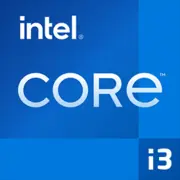Intel Core i3-N300

Intel Core i3-N300: Compact Energy Efficiency for Everyday Tasks
March 2025
Introduction
Laptops with ultra-low power processors are becoming increasingly popular—chosen by those who prioritize mobility and battery life. The Intel Core i3-N300, introduced in 2023, remains a relevant solution for budget ultrabooks and entry-level devices. In this article, we will discuss who this chip is suitable for, how it performs tasks, and what nuances to pay attention to when purchasing.
Architecture and Technology Process: Efficiency Above All
Codename Alder Lake N, Intel 7 process technology
The Core i3-N300 belongs to the Alder Lake N family, designed for devices with minimal thermal output. Unlike the classic hybrid Alder Lake processors (with P- and E-cores), it features 8 energy-efficient Gracemont cores (E-cores) with no Hyper-Threading support. This means 8 threads running at a base frequency of 1.8 GHz, with a turbo boost of up to 3.8 GHz.
Integrated Graphics Intel UHD
The iGPU has 32 execution units (EUs) and a frequency of up to 1.25 GHz. It is not a gaming solution, but it is sufficient for decoding 4K video, working with office applications, and lightweight 2D games.
Cache and Memory
The L3 cache is 6 MB, and RAM support is limited to DDR4/LPDDR5 (up to 16 GB, 4800 MHz). This imposes restrictions on multitasking, but it is quite adequate for the targeted usage scenarios.
Power Consumption and TDP: Record-Breaking Efficiency
The processor's TDP is 7 W, allowing it to operate with passive cooling or a compact heatsink. This is a key feature of the chip: it is designed for devices where silence and long battery life are critical.
Power-Saving Technologies
- Intel Dynamic Tuning 2.0: Adapts power regulation based on load.
- Deep sleep states (C-states): Shuts down unused cores to reduce power consumption during idle time.
- Speed Shift: Quickly adjusts frequency for responsive performance without delays.
In idle mode, the processor consumes less than 1 W, which is crucial for laptops with a 40–50 Wh battery.
Performance: What Can the Core i3-N300 Do?
Geekbench 6: Single-Core 896, Multi-Core 3364
These scores are comparable to the Intel Core i5-1135G7 (Tiger Lake), but the N300 lags in multi-threaded tasks due to the absence of P-cores.
Real-World Scenarios:
- Office Work: Browser with 10+ tabs, Word, Excel—no issues.
- Multimedia: 4K video streaming, video calls, basic editing in Shotcut or DaVinci Resolve (with limitations).
- Gaming: Only 2D platformers (Hollow Knight) or older games (CS:GO on low settings, ~30 FPS).
Turbo Boost Mode
When 1–2 cores are under load, the frequency increases to 3.8 GHz, speeding up everyday task responsiveness. However, under full load on all cores, the turbo boost lasts a short time due to TDP limits.
Use Cases: Who Is This Processor For?
1. Students—for lectures, text work, and Zoom.
2. Office Workers—basic tasks, cloud services.
3. Travelers—compact laptops with battery life of 10–14 hours.
4. Secondary Device—as an addition to a powerful desktop PC.
Not Suitable For:
- Professional video editing/3D rendering.
- Modern gaming.
- Heavy multitasking (e.g., running virtual machines simultaneously).
Battery Life: How Long Will It Last?
Laptops with the Core i3-N300 typically come equipped with batteries of 40–60 Wh. With moderate usage (brightness at 50%, Wi-Fi, browser):
- 10–12 hours—for models with LPDDR5 and IPS displays.
- 8–10 hours—with active use (streaming, video).
Tips for Battery Saving:
- Enable "Power Saving" mode in Windows.
- Use dark interface themes (particularly effective for OLED displays).
- Disable background applications.
Comparison with Competitors
1. AMD Athlon Gold 7220U (Zen 2): Similar TDP (8 W), but only 2 cores. In multi-threaded tasks, the N300 is 40% faster.
2. Apple M1: 2–3 times more powerful, but laptops with M1 start at $800, while devices with N300 start from $300.
3. Intel Pentium Silver N6000 (2021): Outdated architecture. In Geekbench 6 Multi-Core, the N300 outperforms it by 3 times.
Conclusion: Core i3-N300 is optimal in the budget segment for those who prioritize core count over high IPC (performance per clock).
Pros and Cons
Strengths:
- Record-low power consumption.
- Sufficient cores for light multitasking.
- Low device price (starting from $300).
Weaknesses:
- No support for Thunderbolt 4.
- Limited GPU performance.
- Maximum of 16 GB RAM.
Laptop Selection Recommendations
Types of Devices:
- Ultrabooks: For example, Acer Swift 1 or Lenovo IdeaPad Slim 3.
- Student Laptops: Dell Inspiron 14 3420 (price: ~$350).
- Convertibles: ASUS ExpertBook B3 Flip (touchscreen, stylus).
What to Look For:
1. Display: Full HD IPS at a minimum.
2. Storage: SSD is a must (256 GB and up).
3. Ports: USB-C with charging support, HDMI.
4. RAM: 8 GB minimum, 16 GB for “just in case”.
Final Conclusion
The Intel Core i3-N300 is an ideal processor for those seeking an affordable yet durable laptop for basic tasks. It may not impress with speed, but it ensures smooth operation in office applications, browsers, and messaging apps. Its main advantages are battery life up to 12 hours, silent operation, and an affordable price. If your requirements remain within the realm of everyday work, the Core i3-N300 will be a reliable choice. However, for gaming or professional tasks, consider more powerful solutions—at least Intel Core i5 or AMD Ryzen 5.
Basic
CPU Specifications
Memory Specifications
GPU Specifications
Miscellaneous
Benchmarks
Compared to Other CPU
Share in social media
Or Link To Us
<a href="https://cputronic.com/cpu/intel-core-i3-n300" target="_blank">Intel Core i3-N300</a>